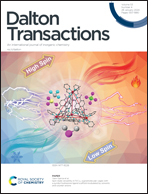Bifunctional 3D POM-based coordination polymers for improved pseudocapacitance and catalytic oxidation performance†
Abstract
Developing novel high-efficiency supercapacitors as energy storage devices to solve the energy crisis is of vital significance. Meanwhile, designing highly active and selective oxidation catalysts for various sulfides is desirable but still a big challenge. To work out these problems, three novel 3D POM-based coordination polymers (POMCPs), formulated as [{Ag6(pytz)4}{SiMo12O40}] (1), [{Cu3(pytz)4}{SiMo12O40}]·5.5H2O (2) and [{Cu6(pytz)6}{SiMo12O40}]·2H2O (3) (pytz = 4-(5-(4-pyridyl)-1H-tetrazole)), are successfully prepared via a one-step synthetic strategy by changing different temperatures under hydrothermal or solvothermal conditions. In compounds 1 and 2, {SiMo12}, as 9-capped and 2-capped polyoxoanions, are engaged among the 2D Ag/Cu-organic sheets to generate the novel 3D POM-based coordination polymers. In addition, 1D Cu-organic chains are combined with 3-capped {SiMo12} polyoxoanions to construct 2D POM-based coordination polymers in 3. To our delight, as electrode materials for supercapacitors, the three compounds exhibit excellent specific capacitances of 261.76 F g−1, 248.82 F g−1 and 156.47 F g−1 at 0.5 A g−1, respectively. Besides, they can effectively and selectively catalyze the oxidation of various sulfides to sulfoxides.



 Please wait while we load your content...
Please wait while we load your content...